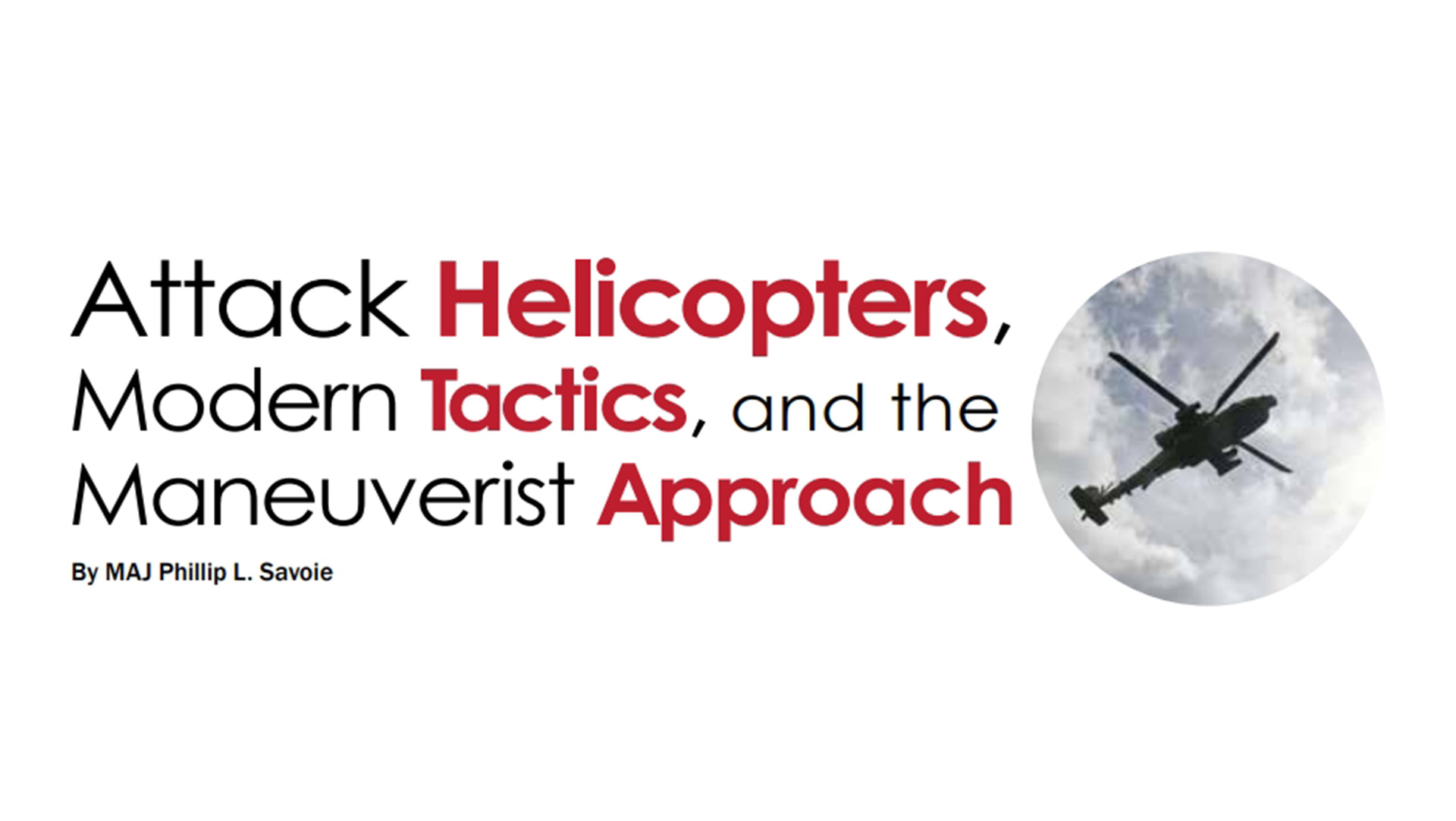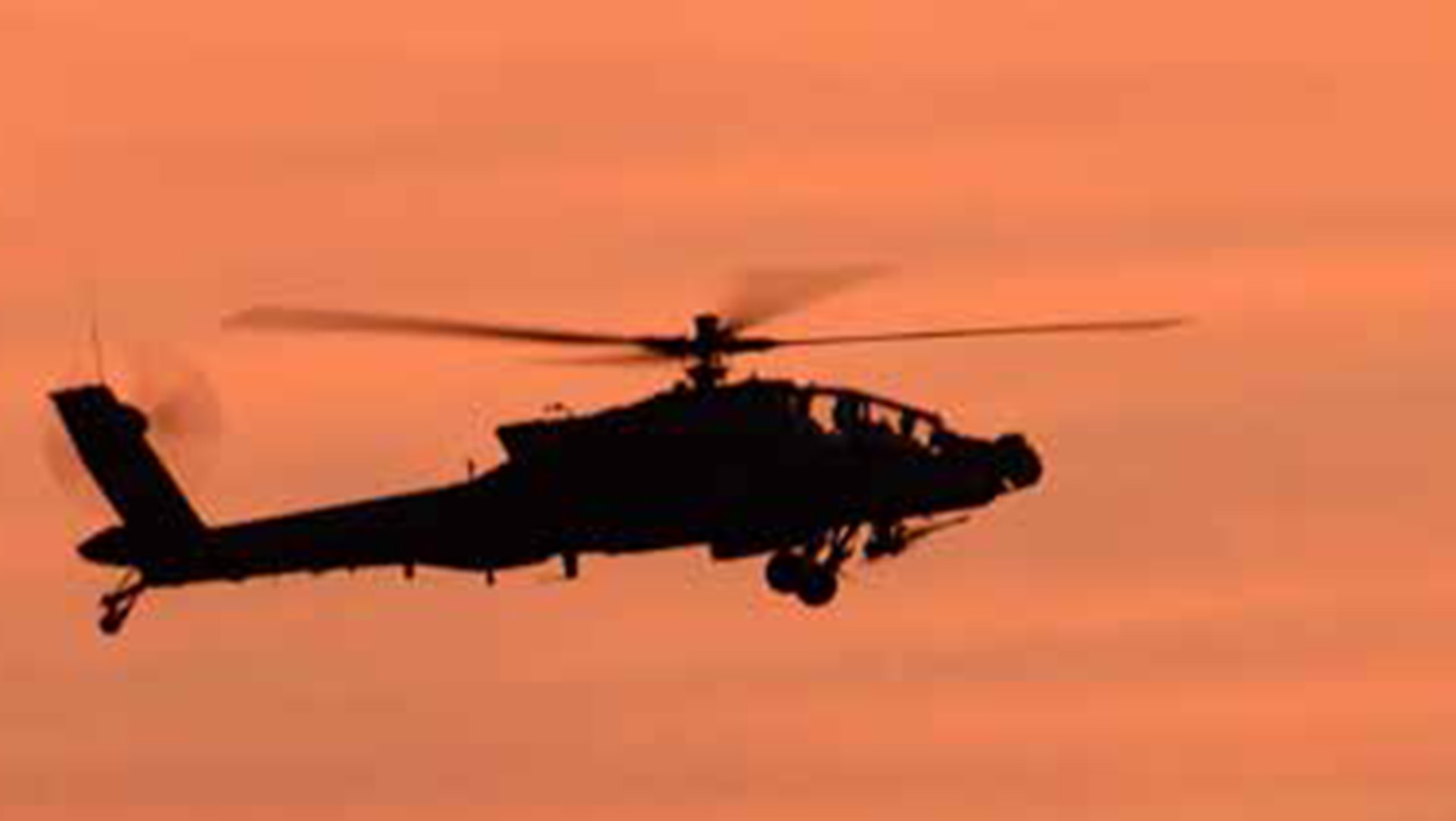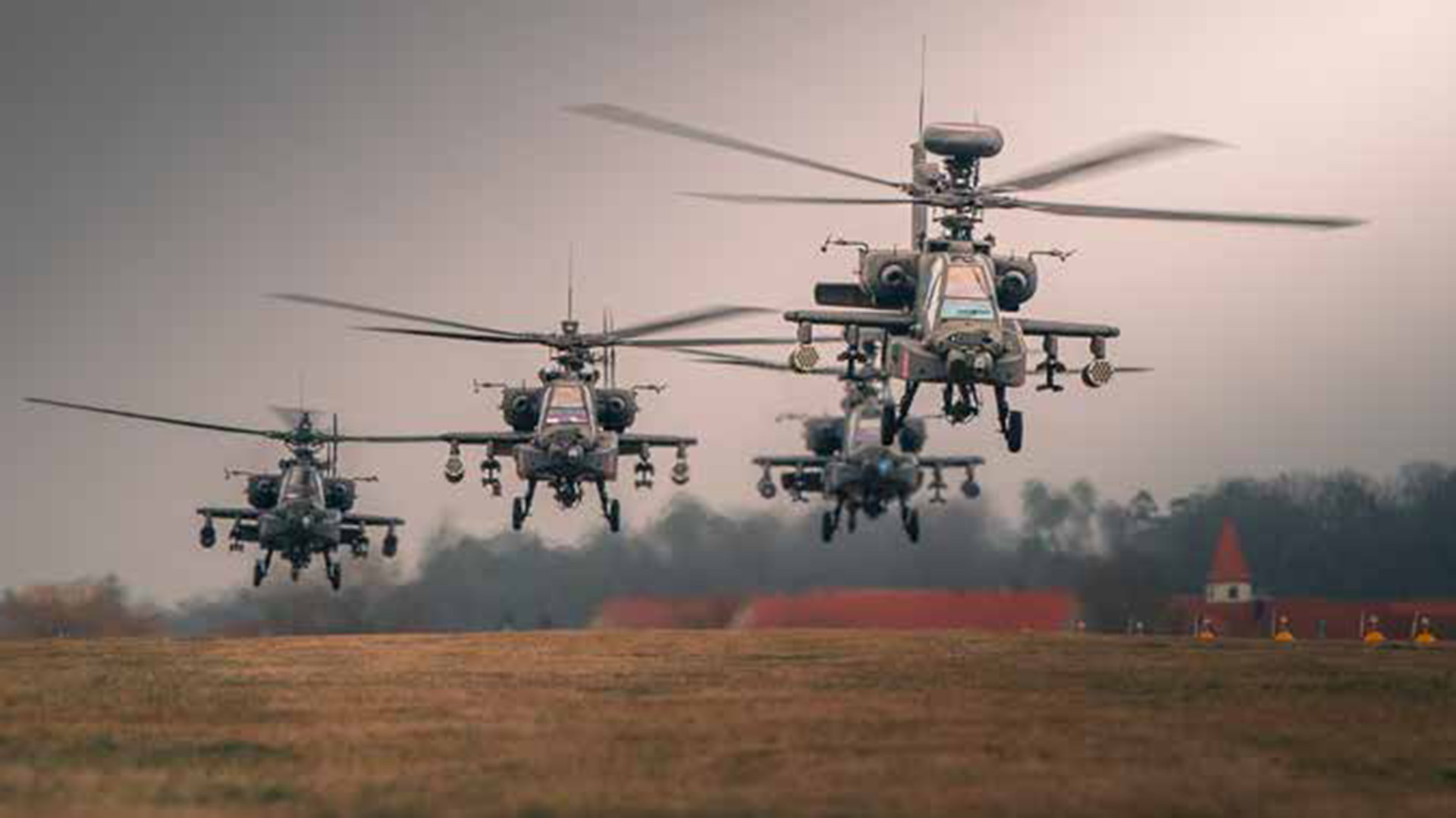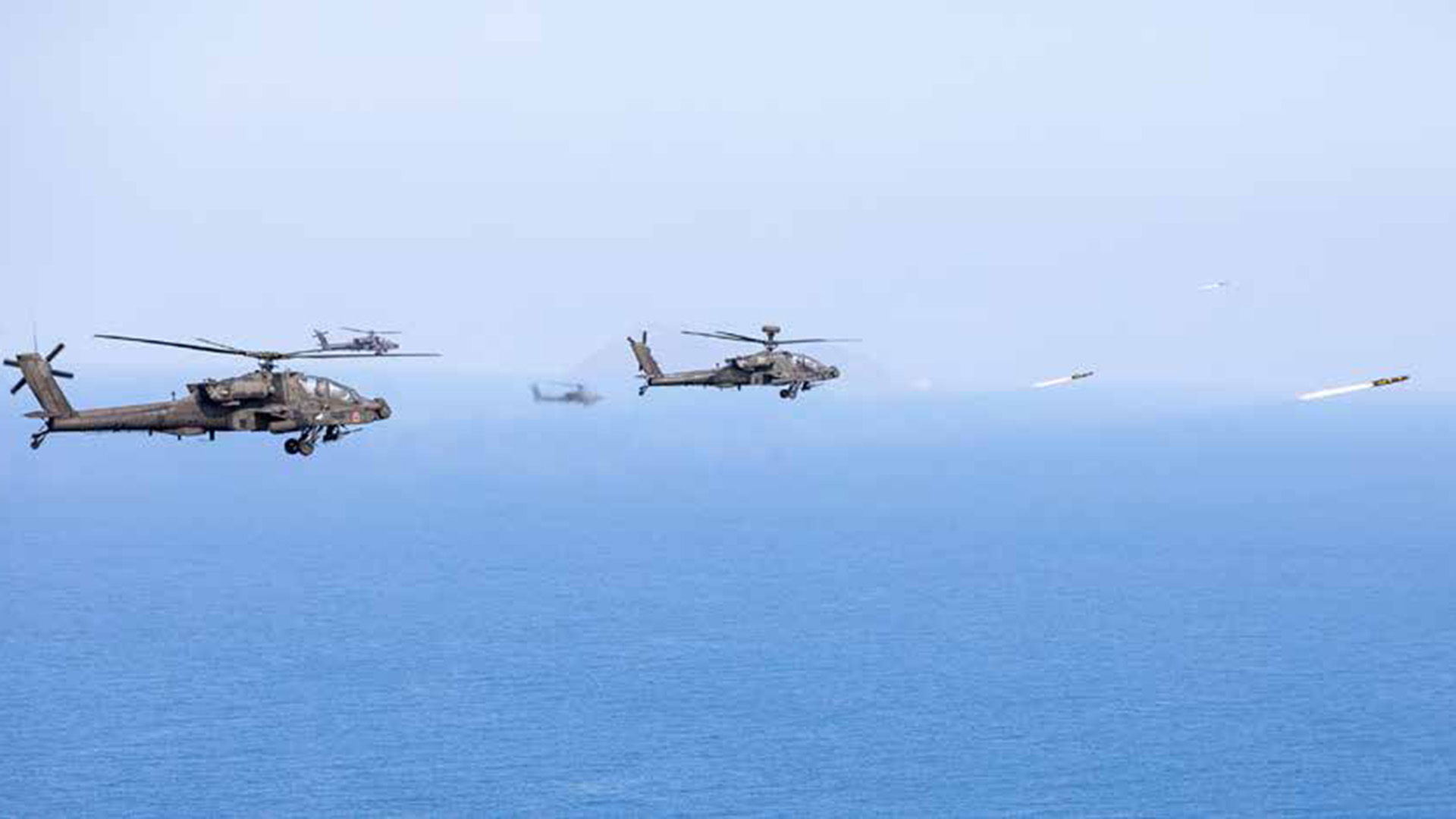Attack Helicopters, Modern Tactics, and the Maneuverist Approach
By MAJ Phillip L. Savoie
Article published on: October 1, 2024 in the Aviation Digest October-December 2024 Issue
Read Time: < 9 mins

An AH-64E Apache Helicopter takes of from the U.S. Army Airfeld at the Baumholder Maneuver
Training Area (Germany). U.S. Army photo by Ruediger Hess.
An aviator observing recent attack helicopter operations—especially those coming out of Ukraine—is likely to come
to two opposing conclusions. On one hand, the attack helicopter’s future seems questionable, with commentators
pointing to high Russian helicopters’ losses in Ukraine. On the other hand, Russian attack helicopters played a
role in defeating Ukraine’s counteroffensive, and their bases are priority targets indicating the Ukrainians
view aviation as a significant threat. To make sense of these opposing conclusions, attack aviators should
understand two concepts: “Modern System” tactics and the maneuverist approach. This article will explain these
concepts and apply them to attack helicopter operations in large-scale combat (LSC).
Modern System Tactics and Aviation
Twentieth-century armies adapted to firepower proliferation with tactics that use cover, concealment,
dispersion, small-unit maneuvering, suppression, and combined arms. Shrewd use of terrain could overcome the
proliferation of firepower. Stephen Biddle, a historian, called these tactics the Modern System and argued
armies’ ability to employ Modern Systems has been the key determinant to success in modern conventional wars
(Biddle, 2006). While Modern Systems tactics will seem obvious to most military members today, they were
revolutionary when developed. Even today, they are often hard to employ and require a high degree of training at
low levels.
The Modern System concept sheds insight into how Army Aviation successfully operates in LSC. While Biddle’s
Modern System describes ground combat, its concepts can also apply to aviation. Conventional adversaries can
wield a ‘storm of steel’ against helicopters with small arms, anti-aircraft guns, anti-tank, radar-guided and
infrared seeking missiles, and more. This threat pushes helicopter operations to terrain flight altitudes where
cover and concealment mitigate the threat. However, this comes with a tradeoff. It is more difficult to identify
and engage a threat from lower altitudes.
A Maneuverist Approach
Aviation is a maneuver branch, meaning it maneuvers in time and space to gain advantage over the enemy. Most
aviators understand maneuvering around enemy strength to gain a spatial advantage, but maneuvering in time is
less understood. Military units are in one of three postures at a given time: protected, moving, or striking.
Protected units are stationary and in a strong defensive posture, often with deliberately prepared cover and
concealment. Moving units are the most vulnerable and exposed while in transit. Striking units are similarly
vulnerable, deliberately exposing themselves during their engagement sequence (Leonhard, 2017). A historical and
easy to visualize example of these postures is Napoleonic-era infantry shifting formations between line—a strike
posture, column—a movement posture, and square—a protected posture. At a given moment, a military unit will tend
toward one of those postures.
Aviators must consider both their own posture and their opponent's posture. During an attack helicopter mission,
postures change many times. At terrain flight altitudes, an attack helicopter moves and protects itself en route
to a battle position. Terrain may not provide complete protection along the route, but movement speed reduces
exposure time. Once masked in a battle position, a helicopter is in its most protected posture. When the
helicopter unmasks to make direct contact, it moves to a striking posture at the expense of protection. To
identify and engage a target, an attack aviator completes the direct fire engagement process (DIDEA—detect,
identify, decide, engage, assess) while remaining in the striking posture. After an engagement, the helicopter
masks—returning to a protected posture—and moves to subsequent battle positions.
During an attack helicopter mission, enemy ground units are also in different postures. A well-protected enemy
unit is concealed under camo nets or in a tree line where attack helicopters’ sensors cannot easily acquire it.
A striking enemy unit temporarily exposes itself— this exposure may be visual, electronic, or through direct or
indirect fires—as it goes through its engagement sequence. A moving enemy unit is most exposed and while still
capable of striking, it is less effective. Air defense coverage is more difficult to provide for a moving force,
leading to potential gaps in coverage. Enemy units will try to minimize exposure time by moving rapidly and
maneuvering to new protected positions where they can better strike friendly units.

A U.S. Army AH-64 Apache helicopter conducts a traffic pattern training fight at Katterbach
Army Airfeld in Ansbach, Bavaria, Germany. U.S. Army photo by Charles Rosemond/released.
Attack helicopters are most effective against moving targets. Target acquisition is easiest against a moving
threat because it minimizes the exposure time needed to complete the direct fire engagement process.
Additionally, gaps in air defense coverage while a target is moving further increases attack helicopters’
advantages against moving targets. Stationary units are problematic for attack helicopters. Any AH-64 front
seater with experience at the combat training centers understands the difficulty of ac quiring a target at
standoff range hidden in trees or deliberately concealed with camo netting. Target acquisition is possible;
however, it is usually accomplished after a more extended time searching from an exposed posture. This places a
dilemma on an attack aviator—remain masked without the ability to successfully complete the direct fire
engagement process—or adopt a more exposed striking position for a longer period to attempt target acquisition.
Applying the Concepts
Army Aviators should understand these concepts and adopt a maneuverist approach to apply strength against enemy
weaknesses. Planning that considers when an enemy is most vulnerable can maximize advantageous situations.
Identifying when and where the enemy is moving or in a vulnerable position is key. Intelligence preparation of
the operational environment can identify possible avenues of approach and times when the enemy is likely to
move. A well-designed information collection plan—potentially incorporating the unmanned aircraft system (UAS)
Gray Eagle’s moving target indicator capability—can assist attack helicopters in arriving at engagement areas at
the same time as the target, minimizing their exposure.
Aviation operations should seek opportunities when friendly ground maneuver compels the enemy to leave its
protected posture, achieving the multidomain imperative of imposing multiple dilemmas on the enemy. For example,
attack helicopters can remain in reserve until friendly forces capture an objective and then come forward to
defeat an enemy counterattack. Similarly, friendly ground maneuver, such as an envelopment or turning movement
may compel an enemy to displace setting the stage for a pursuit. Historically, attack aviation finds enemy units
exposed and without adequate defense in a pursuit. During the Gulf War, the Highway of Death provides a classic
example when aviation units inflicted heavy losses on Iraqi units caught in the open while retreating from
Kuwait (Atkinson, 1993). Similarly, during the Normandy campaign, German units hastily retreating through the
Falaise gap suffered heavy casualties from Allied aircraft (Atkinson, 2013).
Sometimes, the mission dictates targeting stationary units despite the desirability of attacking moving targets.
Aviators must understand the disadvantages of this situation and take mitigating steps. The first disadvantage
is the difficulty in finding an enemy in a protected and concealed posture. The multidomain imperative to make
initial contact with the smallest element helps mitigate this risk with attack aviators relying on UAS or ground
forces to make initial contact. The second disadvantage is that the attack sequence takes longer due to the
difficulty in establishing direct contact. Aviators can mitigate this risk through conducting remote
Hellfire engagements, thus eliminating the attack helicopter’s need to conduct the direct fire
engagement process.
If the mission still requires attack helicopters to gain initial contact and complete the direct fire engagement
process, aviators mitigate risk through fire support coordination and suppression of enemy air defense. Fires
enable maneuver and are an imperative for exposed maneuver. In this case, fires are needed to enable attack
helicopters to unmask or maneuver in exposed positions to gain contact and complete the engagement sequence
successfully.

AH-64 Apache attack helicopters launch from Katterbach Army Airfeld for a battalion attack
training mission. U.S. Army photo by MAJ Robert Fellingham.
Evidence in Current Operations
A cursory overview of Russian helicopter operations in Ukraine from open-source media confirms the previous
concepts (Bronk et al., 2022, pp. 21-23). The initial air assault on Hostomel airport saw many helicopters
operating without the use of terrain called for by the Modern System, with attack helicopters operating in the
open shot down by man-portable air-defense system teams (War Leaks-Military Blog, 2022). Adjusting to the lethal
conditions, additional videos show attack helicopters firing rockets blindly while masked behind friendly lines.
Russian aviators appear to have adapted to the lethal conditions by maximizing protection but with a degraded
ability to strike (Newdick, 2022). Likewise, further videos show exposed Russian helicopters attempting to
strike Ukrainian positions with anti-tank missiles. The lengthy exposure time while the Russian helicopter
attempts to complete its engagement sequence results in its shootdown by a Ukrainian missile team (Retro Foto
House, 2023). When Russian helicopters did achieve success during the Ukrainian summer 2023 counteroffensive,
they attacked moving Ukrainian vehicles that did not have coordinated air defense coverage (Roblin, 2023).

U.S. Army AH-64D Apache Longbow helicopters participate in a Hellfire Missile Shoot
at Greek Karavia, Range Complex, Greece. U.S. Army photo by CPT Gabrielle Hildebrand.
Conclusion
Modern System tactics and a maneuverist approach provide insight on the opposing conclusions about attack
helicopters’ viability in LSC. Aviators must be canny about both when and where they are employed. A maneuverist
approach allows aviation to fight from an advantageous situation or take deliberate steps to avoid an unfair
fight if required to fight at a disadvantage. This means attack helicopter operations in LSC will be more
sparing and more deliberate. Preferencing attack helicopter use against moving targets requires commanders to
husband them until the enemy moves. If the mission dictates attack helicopters' use against stationary targets,
it requires deliberate planning and execution, meaning these operations will be slower-paced and unlikely to
result in decisive engagements with high enemy casualties. Understanding the conditions that disadvantage attack
aviation allows more deliberate decision-making regarding employment.
The days of operating at altitude with easy battlefield visibility and relative invulnerability from threat
systems—as done in Iraq and Afghanistan—are gone. Army Aviation’s inherent mobility, speed, range, flexibility,
lethality, precision, and persistent reconnaissance capabilities provide the combined arms team with a
formidable capability. Even the mere presence of aviation complicates enemy planning and potentially fixes the
enemy while friendly ground forces maneuver against it. The current force structure is heavily reliant on manned
attack helicopters. Bringing those assets to bear requires dialogue between aviators and ground commanders on
how best to utilize attack aviation. Fortunately, tactics involving the Modern System and a maneuverist approach
to fighting are the ground forces' language. Aviators better versed in these concepts will be better members of
the combined arms team during LSC.
References
Atkinson, R. (1993). Crusade: The untold story of the Persian Gulf War. Houghton Mifin Company
Atkinson, R. (2013). The guns at last light: The war in Western Europe, 1944–1995 (Vol. 3). Picador.
Biddle, S. (2006). Military power: Explaining victory and defeat in modern battle. Princeton
University Press
Bronk, J., Reynolds, N., & Watling, J. (2022, November 7). The Russian air war and Ukrainian requirements
for air defense. RUSI.
https://www.rusi.org/explore-our-research/publications/special-resources/russian-air-war-and-ukrainian-requirements-air-defence
Leonhard, R. R. (2017). Fighting by minutes: Time and the art of war (2nd ed.). CreateSpace
Independent Publishing Platform
Newdick, T. (2022, March 18). Russian attack helicopters are now wildly lobbing rockets over Ukraine
(updated). The Warzone.
https://www.twz.com/44803/russian-attack-helicopters-are-now-wildly-lobbing-rockets-over-ukraine
Retro Foto House. (2023). Ukrainian soldiers shoot down Russian KA-52 attack helicopter using STUGNA
anti-tank guided missile [Video].
YouTube. https://www.youtube.com/watch?v=AuSesd8tGVc
Roblin, S. (2023, June 9). Ukraine’s western armor suffered enormous losses while breaching a
minefield. Popular Mechanics.
https://www.popularmechanics.com/military/weapons/a44157100/ukraine-sufers-losses-breaching-minefeld/
WarLeaks Military Blog. (2022). Ukrainie War-Russian KA-52 emergency landing during combat sortie at
Hostomel airport-POV [Video]. YouTube.
https://www.youtube.com/watch?v=oLa3fZD1vXs
Author
MAJ Phillip Savoie is an AH-64D aviator with 11 years of service. Previous assignments include two company
commands in Germany and serving as a Cavalry/ATK Observer-Coach/Trainer at the National Training Center. He
is currently attending Intermediate Level Education at Fort Leavenworth, Kansas.